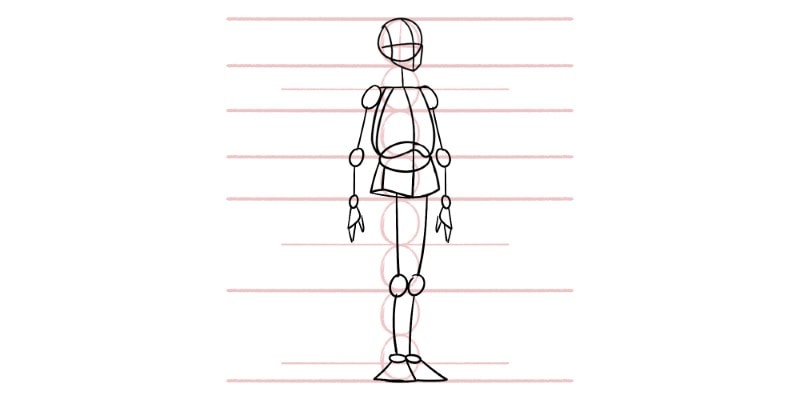When drawing the human body, you might have heard about some terms like “gesture drawing” and “figure drawing”. But what exactly are they? And what are the differences between gesture drawing and figure drawing?
Simply put, Figure Drawing is a term used to refer to any and every drawing of the human body. Gesture Drawing is a quick and simple exercise, where you draw the human figure in as few strokes as possible. By definition, gesture drawing is actually a type of figure drawing!
There are many terms when it comes to art and drawing and sometimes they are so similar, that it can be confusing.
But let’s delve a bit more into Figure and Gesture Drawing so we can understand them better, once and for all!
Table Of Contents
What Is Gesture Drawing?
A gesture drawing is a very helpful exercise where you capture the form, movement (action), pose, and even mood of a subject with as few strokes as possible.
These drawings are very quick and simple. The idea here is for you to be able to capture the whole pose and action, without focusing on details.
Usually, you’ll time yourself, so you’re sure you won’t be thinking or drawing any unnecessary details at the moment.
Generally speaking, 2 minutes should be enough to capture the overall feeling of a pose.
You can add more or less time, depending on how detailed you want your gesture to be!
If you’re looking for more drawing exercises, check out this article on the best anatomy drawing exercises to improve quickly.
But why is it called Gesture Drawing? As we’ve just been through, this is a very quick drawing exercise.
We draw the subject with very quick gestures of our hand and arm, so the pose and lines can be as dynamic as possible.

These gestures are quick and deliberate.
At first, especially knowing you are being timed, it feels hard to capture a pose in such little time.
But with practice, you’ll notice you’ll start understanding what’s important to capture, to better translate the pose into paper.
You are not trying to draw perfect anatomy, composition, or even a finished art piece.
The goal here is to create more dynamic poses, understand how the body moves, and feel more comfortable putting a pencil into paper.
You can learn everything there is to know about Gesture Drawing (including examples and tips) in my article here.
While you’re learning and getting more comfortable with the idea of drawing the human body, this exercise will also teach you to be more fluid with your lines!
What Is Figure Drawing?
Besides Gesture Drawing, chances are you’ve heard about Figure Drawing as well.
There are very similar terms in the art world and it might be a bit confusing to discern one from the other. Especially at the beginning, when everything sounds so alien to us!
To put it simply, Figure Drawing is the term used when talking about any kind of drawing of the human body.
Whether it’s a simple and quick sketch or a very detailed drawing of a person, it is considered a Figure Drawing.
Your subject can be acting out any kind of action, they could be fully clothed or in the nude. Simple and loose shapes or complete rendering.
It doesn’t matter in what form or medium, you made a Figure Drawing.
And if you’re curious about it, click here to learn figure drawing in my completely free guide.
But you might ask yourself: but doesn’t that mean that Gesture Drawing is a kind of Figure Drawing?
Yes! Gesture drawing is indeed a form of Figure drawing. It’s the quickest way of drawing the human body.

It doesn’t matter how simplified it is, as long as the pose has been captured and you can tell there’s a human body in your drawing, then you just did a Figure Drawing!
If you want to learn how to draw people or create your own characters, it’s very important to go through different exercises.
Personally, I think Gesture Drawing can be very helpful for that. And if you watch any of my classes or courses, I almost always go through a few Gesture exercises to encourage my students into trying it.
Most of the time, people feel much more confident about their lines and figure drawings after trying it out!
Not only that, but there are a lot of anatomy and figure drawing books around that show you different ways of capturing both gestures and more detailed drawings of the human body.
We do have an article on our 6 favorite and best anatomy reference books for artists, and I think it’s worth checking out!
Main Differences Between Figure Drawing And Gesture Drawing
The main difference between Figure Drawing and Gesture Drawing is that Figure Drawing is a term used to refer to any and every drawing of the human body.
Inside the term Figure Drawing, you can find many other terms/exercises that refer to different types of drawings of the human body.
Gesture Drawing is an example of that!

As we’ve seen, gesture drawing is a quick and simple exercise, where you draw the human figure in as few strokes as possible.
It doesn’t matter how simplified it is, as long as you can identify it as a body and a pose, then it is a Figure Drawing!
Now, of course, Gesture is not the only exercise you can do when talking about Figure Drawing exercises.
You can make a complete rendering of the human body, for example. Or even make studies of specific parts of the body and it could still be considered figure drawing!
Not only that but you can use a pencil or a pen, on paper or digitally.
If it’s a body, then you have a Figure Drawing.
What Is The Difference Between Gesture Drawing And Contour Drawing?
When doing a gesture drawing, we apply quick strokes on paper, to capture the whole pose of a figure.
Here, we focus on the big picture, figuring out what are the most important lines in a pose, so it is recognizable on paper.
In a Contour Drawing, however, our focus isn’t on the overall pose/subject anymore, but on its outline.
I talk more about what is Contour Drawing, and show you some examples in this article.
A lot of the time, the goal of Contour Drawing is to capture the entire subject, by using one continuous line.
This drives us to take a closer look at the subject or image.
Where in gesture drawing, we want to see and capture the general look of our subject or pose, in contour, we want to pay attention to the detail.

With this exercise, you’ll also learn to make choices.
One of the goals here is to avoid lifting the pencil from the paper as much as possible.
You’ve possibly tried doing this before, probably as a kid even. I know I had fun with that sort of exercise while growing up.
And if you did, you know how hard it can be to draw something clear and understandable without lifting the pencil.
So when making a contour drawing, you have to make important decisions, such as where are you starting your line and where and how it will connect along the drawing.
With practice, you’ll start knowing and understanding how to better place and trace your line, so they don’t overlap and create a detailed drawing of the human figure!
Just like gesture drawing, a contour drawing can be as detailed or as simple as you want.
Not only that, but it also falls in the Figure Drawing category.
Here, you’ll also draw the human body, just with a different approach!
What Is The Difference Between Figure Drawing And Portrait?
While Figure Drawing refers to drawings of the human body as a whole, a portrait refers to a drawing of a particular person, usually their face.
These drawings tend to focus on the face. Even though you can draw part or even the whole body of that person, the main focus is always the face and expressions.
Generally speaking, when you’re making studies of the human body, you don’t focus a lot on the face and its particularities.
Not only that, but you also don’t put much thought into it. That means the face you’re drawing isn’t particularly representative of a specific person.
In figure drawing you’re usually drawing the whole body. In a portrait you’re focusing on a specific part of the human body.
Most of the time, you’re not looking to make a perfect replication of a subject and their demeanor.
All you want is to make sure your anatomy is right!
However, with a portrait, what you’re looking for here is to capture the essence of the person you’re painting/drawing.

The way they smile and pose is important. How are their features positioned and their proportions matter as well.
You’re not just drawing a face, you’re also trying to capture their personality in your drawing!
In short, figure drawing is an anatomy study. Most of the time, you’re drawing the whole body.
In a portrait, you’re focusing on a specific part of the human body, specifically from a particular person.
Should I Learn Gesture Drawing First?

In my personal opinion, if you want to draw anatomy and want to get better at drawing and understanding the human body, gesture drawing is a must!
When learning to draw, we tend to focus too much on specifics and details. Which, at some point, are important to know and learn.
However, I feel that we tend to frustrate ourselves in trying to get details right when we still don’t understand the overall form of the human body.
Sometimes it’s good to step back and simplify things as much as possible.
And gesture drawing will do just that! Instead of thinking about every single detail, we’re taking a step back and focusing on what makes the human body, a human body.
I have an article on how to Master Gesture Drawing right here for you.
What’s important to capture to make it identifiable?
This exercise will help you have a clear idea of how the body moves and works.
You’ll start to understand its proportions better as well, even if they’re not your main focus.
Not only that, but gesture drawing will help you relax and feel more confident in your lines.
You’ll have to be quick, so you can capture the pose as best as you can with as little time as you have.
For that, you can’t focus on how perfect your line is. We tend to draw our lines very slowly at first because we’re afraid of making a mistake.
But the fact is, that won’t make your lines look better. Fluid, confident and quick lines do that!
And you’ll see that after a few tries, you’ll feel much more confident in drawing quick and long strokes to capture beautiful poses.
This is something that we cover extensively in our Complete Figure Drawing Course. So you can click here to get a special discount code for making it this far in the article!

Patricia Caldeira is the main writer here at Don Corgi. She's an art teacher with over 20.000 happy students across many platforms and courses!
Enjoy your stay and as always:
Keep on drawing!







